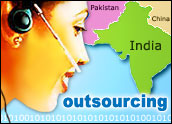
Acquisition of existing enterprises offers the quickest, safest route to entering new markets and expanding rapidly within existing markets. The alternative route is organic growth through traditional sales and marketing efforts.
We begin here by recognizing the limits of conventional sales and marketing campaigns, then shift to discussing minimum deal sizes and the identification of acquisition candidates.
The limits of conventional growth strategies can be observed among firms from outside North America who attempt to gain access to the lucrative U.S. market for business process outsourcing (BPO) or customer service contracts. Such firms can find themselves spending between US$200,000 and $250,000 per year per person to operate a sales office in the U.S., including administrative and fringe costs.
Identifying outsourcing leads and beginning the sales cycle can easily take six months or more. The sales cycle for major inbound call center outsourcing contracts usually ranges from 6 to 18 months. At the end of this process, a firm can burn through two million dollars, spend two years in limbo and still fail to gain any business. Meanwhile there is usually a professionally staffed outsourcing facility sitting idle somewhere, consuming additional funds.
Once a firm has become established in the U.S. market, sales efforts can become self sustaining. But growth beyond a steady state can require incredible amounts of time and money.
Firms from outside the U.S. who have little or no U.S. experience are highly unlikely to reach high levels of growth and profitability in a market saturated with experienced Indian call centers and BPO service providers. Market entrants from emerging destinations such as Pakistan, Sri Lanka, Kenya and the Persian Gulf are finding that some potential clients are turning them down until those destinations have become more established and have proven themselves with major U.S. clients.
In summary, growth through acquisitions may be the only feasible option for new firms or for those from emerging destinations. For existing offshore outsourcing service providers, growth through acquisitions can offer the cheapest, quickest route to expansion.
Advantages of Buying an Existing Firm
Describing the advantages of buying an existing firm is akin to describing what is actually being purchased. There is a misunderstanding among some business buyers and sellers who I have worked for in India that the value of a business is primarily determined by the original cost of the physical assets of the firm being sold.
The physical assets of an acquired outsourcing firm rarely approach the value of the firm itself, except in liquidation sales of assets from an operation that has been closed or is devoid of legitimate clients. Buyers who equate the value of a firm with the original sales prices of its physical assets would be better served by shopping around for new equipment.
The major advantage of buying an existing firm is that it provides a ready-made client base. However, it is the confidence of the client base that determines the value proposition in an acquisition of this type. If clients lose confidence in new owners, clients can desert a firm and render it worthless. Methods for preserving client confidence will be addressed in a subsequent article in this series.
Buying an existing business can enable the new owners to borrow funds or raise additional capital. Additional capital can support moving production or service operations to more competitive locations.
Attempts to ramp up customer service programs too fast and with too many seats can lead to outsourcing program failures. Buying an existing operation enables programs to be shifted gradually and for new staff offshore to be trained and coached in small batches, easing workloads for recruiters, trainers, and quality assurance staff.
A constraint facing specialized operations offshore is the inability to find senior North American staff who are willing to spend long periods of time onsite. Buying an existing operation makes it easier to manage initial process migration and long-term program implementation. Managers from a purchased facility can be assigned to go overseas (possibly in month-long rotations) and local managers from overseas can spend time at an acquired facility in the U.S.
The buyer’s offshore managers and trainers should spend time at the newly acquired North American facility in order to gain the following:
- Domain expertise in the subject matter of the acquired firm
- Operations training
- Immersion in the corporate culture of both the acquired firm and its clients
- Personal contacts that unify business operations
Deal Size
U.S. outsourcing firms can be purchased for as little as four million US dollars, including transaction costs. However, firms in that price range are often so small or in such bad shape that they are not worth the effort to acquire. Micro deals or acquisitions of troubled firms are best left to buyers who have special expertise with small acquisitions or in salvaging troubled U.S. firms.
Minimum feasible deal sizes vary according to the type of industry niche that the seller occupies. Small document management companies could make good acquisition targets in the $5 million to $20 million price range. Collections firms need to be at least $20 million in order to be viable, with the best profit opportunities at $40 million or more.
An acquisition that is too small will not give the buyer enough work that can be shifted to more economical locations. In the collections field, for example, only about half of a $20 million firm’s volume could be readily moved offshore. The remainder often requires negotiation skills and domain expertise that is best performed at the incumbent location. Additional volumes can be shifted safely once offshore staff gain experience and expertise, but buyers should consider a go-slow approach to avoid losing clients and thereby damaging the value of their acquisition.
Buying a minority stake in an outsourcing firm may appear to provide good value for the money. In reality, a minority stake can be a waste of resources because it does not obligate the seller to give up control over the enterprise. The seller is free to continue to sell minority shares and dilute the value of the original shares that were sold.
Identifying Buyout Candidates
Buying an existing firm can be exceedingly risky for buyers who lack recent experience with similar acquisitions on both the buy and sell sides in the same market and industry. The highest risks are faced by buyers from outside North America who are attempting to make their first U.S. acquisition. These risks, when realized, can create a huge drain on a buyer’s finances if an acquisition fails to produce the anticipated results.
In high-tech fields where entrepreneurs are accustomed to making a range of ground-breaking moves into uncharted territory, an acquisition of a U.S. firm may appear to be just another new project. However, buying another business entity is not a technical exercise. It is an operation that requires long-standing personal and professional experience in an environment where neophytes are frequently shunned.
“A man’s got to know his limitations,” said Clint Eastwood’s character in the 1973 action film “Magnum Force.” Nowhere is this truer than in the process of finding and acquiring a U.S. firm.
The biggest limitations that I’ve found that buyers from India and Pakistan bring to the table is that they do not know how to value U.S. acquisition prospects and are quick to overpay for the first acquisition candidate that presents itself. There is widespread confusion about what is actually being purchased.
The acquisitions process can be compared to the process of finding a suitable marriage partner. In both situations it would be a mistake to simply focus on the first candidate that walks through the door.
A safer and ultimately cheaper approach would be to commission an experienced U.S. investment bank to help identify a suitable market segment and then identify and contact roughly 100 targets in that segment. From that initial batch, 40 or so might initially appear suitable and could be approached for additional information and preliminary discussions.
Detailed discussions could be entered into with a short list of 10 firms, four of which could be engaged in negotiations, due diligence and valuation activities. Starting from a broad pool of candidate firms and honing in on the best prospects produces better deals for buyers and sellers.
In upcoming articles, the acquisition process will be explored in greater detail, with practical advice provided for both buyers and sellers.
Anthony Mitchell , an E-Commerce Times columnist, has beeninvolved with the Indian IT industry since 1987, specializing through InternationalStaff.net in offshore process migration, call center program management, turnkey software development and help desk management.















































Social CRM
See all Social CRM